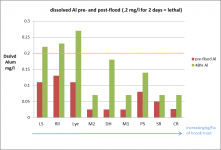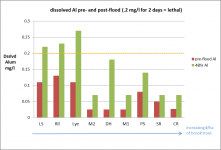Nice psu/schrader study in Figure 11 on p32 shows small trib pH before, during, & after a major flood.
https://www.researchgate.net/publication/237424572_Schrader_Creek_Watershed_Synoptic_Water_Quality_Survey
The pH declines at high discharge, so spring and winter precip events can help show acid rain effects.
On another issue, I am using base-flow aluminum, not alum in flood condition levels, as input to guessing fish populations.
Along with the pH info, the schrader study has brookie surveys for some small tribs in Fig 15/p35, and dissolved alum info before and after flood in Fig 13/p34.
If you start w/ the brookie surveys in Fig 15, the small tribs with low brookie#s are Mill02, Lye, Roll, and LScrdr. (ep18 is main Schrader, not a trib).
Using pre-flood pH in Fig 11, the levels for 2 of the 4 tribs w/ low brookies stand out as low pH (or=.05): Lye, Roll, and LScrdr. (All are over .1 mg/l, red flag 'cause lethal aluminum = .2 for 2 days and it will increase in flood)
Makes sense that aluminum might better signal trout problems, since alum is the actual cause of fish loss in hi discharge. ("Al concentration and duration of high Al concentration are the most important determinants of fish survival." , p33)







